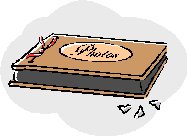Preserving Family Photographs
by Susan
L. Dunn Morua
Now that most modern photographs are digital images, and film negatives are becoming less common, it is becoming increasingly important that we preserve our photographic prints for our descendents. They will not only preserve our memories, they will also tell our descendents who we were, how we lived, and what we liked to do. In addition, incidental details within our photographs will give provide future researchers with valuable information about our society and our culture. So if you want to extend the life of your collection into succeeding generations, here are a few tips that will help your photographs survive.
Handling
- First you need to set up a work
area that is clean and free of food and drink to avoid
accidental spills.
- Next wear washable, clean, white cotton gloves when handling your photographs, because fingerprints contain acid and will over time damage the surface. Archival cotton gloves are inexpensive and readily available from suppliers.
- Pick the prints by their edges, and avoid touching the surface of the image. If the photographs are very large, or damaged, use both hands and make sure you support the back of the print.
|
 |
- The best rule to remember when working with photographs is to
do nothing that cannot be reversed. In other words, do not use
Sellotape, staples, or pins with photographs, and do not write in ink on the back of the prints. If you must write on the back of the photograph, use a soft leaded pencil such as 6B, and try to minimise the amount of writing by only using reference codes (e.g. a number) along the edge of the print. The code number will link the print with identifying notes containing names, places, events, and dates as appropriate for each print.
Light
 |
Since photographic prints result from the action of light upon photographic chemicals and materials, it makes sense that light will also eventually cause photographs to fade.
Colour prints will fade faster than black and white ones, but the latter will also deteriorate if exposed to light over sufficient time.
It’s best then to keep photographs in the dark either in archival boxes or in an archival album with a slip cover. If, however, you would like to put prints into frames for display, it would be better to use copies rather than the originals.
|
Temperature and Humidity
Photographs are actually complex structures made of layers of paper and chemicals and as a result they are sensitive to changes in temperature and humidity. Fluctuating levels of humidity and temperature promote the movement of moisture between the different layers, and this movement speeds up the natural rate of chemical deterioration. Also, high temperatures combined with high rates of humidity can cause microscopic
mould spores to begin growing, and mould is almost impossible to remove.
The most important thing to remember is that photographs should be stored in a location where temperature and humidity levels remain constant so attics, roof spaces, and cellars should be avoided.
Photographs should also not be stored near airing cupboards, radiators, hot water pipes, or sunny windows. In most homes, spare bedrooms, dining rooms, or studies work the best.
Housekeeping
| Fumes from paints, varnishes, thinners, and even standard household cleaning solutions will cause photographs to eventually fade, so they should not be kept in a cupboard with anything else, it would also be wise to avoid keeping them in freshly painted rooms even though storage boxes and enclosures may provide some protection from damaging gases.
In addition, silverfish, beetles, rats, and mice all like to eat photographs, and the natural consequence of this is that the photographs and their enclosures will also be fouled with droppings so you will need to periodically check and clean the storage area. |
 |
Storage Materials
You will need to use materials and products that have been specifically designed for use with photographs, because these will slow the natural aging process. If you don’t use these materials and products, you may find that your photos, despite your careful handling and storage, are discolouring and deteriorating more quickly than you would like.
Any materials and products you are considering buying for the storage of your photographs should
not only be acid-free, they should also have passed the PAT test. PAT is the acronym for Photographic Activity Test. This test meets international standards for ensuring that products so labelled do not contain harmful materials that will interact with the chemicals in photographs.
 |
Ideally it is best to give each print its own enclosure, because this reduce damage to the photograph, but make sure that any plastics you use are clearly labelled that they have passed the PAT. If your photograph collection, however, is large, this could be a costly option, and you may want to consider using albums.
In this case, you will need to use acid-free mounting corners to attach prints to album pages, and place the photographs on only one side of the page so that the images are not facing each other. And as mentioned above, you will also need to ensure that the albums come with slip covers to block light. |
You are going to need separate storage for any
negatives, because the chemicals present in negatives emit gases that are actually harmful to photographic prints. But having said this, it is important to preserve negatives, because they are the camera originals of your photograph collection.
Newer negatives can be stored in specially designed polyethylene or polyester sleeves, but older ones must be stored in paper sleeves, so to be safe, it may be best to use specially designed paper sleeves for all your negatives. You will need to remember to write, in pencil, a reference code on each negative envelope that will link your negatives to your photographs as well as to your notes.
| If you are lucky enough to inherit a family album,
do not take it apart (with one exception described below) to preserve the photos, because the way in which albums are compiled (e.g. subject order, chronological, or by event) along with any captions presents valuable information about the original owner.
If prints are placed within the album on facing pages, then you can use tissue paper that has passed the PAT as interleaving between the pages.
You should not do this with all the pages, because this will make the album too thick, and may cause some pages to bend as well as possibly breaking the spine. The album can then be placed into a flat acid-free box. |
 |
If the album, however, contains self-adhesive pages, you will need to transfer these photographs into a new album, because these albums rely on sticky coatings as well as unknown plastics. But before doing this, you may want to photograph each page of the original album to record any captions as well as the original layout of the prints.
Susan
Dunn Morua has a Master of Science in Library Science with a
specialisation in Rare Books, Photographs, and Historical Documents.
Susan is a Freelance Archivist as well as a Declutterer.
The article was
originally supplied by realchangesltd.com but they appear to no longer
be online.
More detailed information on this
subject can be found
here. Scrapbook.com is a website dedicated to the preservation
and protection of photos, documents, and valuable papers worldwide. They
help protect individuals’ and organizations’ most valuable documents for
future historical purposes, legal archiving, and personal sentimental
value.
Over the past months, they have built one of the most comprehensive
pages on paper, photo, and document preservation on the internet. It has
been compiled to help museum staff, librarians, historians, and
individuals understand how papers deteriorate overtime and the specific
mechanical and chemical techniques that can be used to preserve
documents, photos, and their finishes. However, it not only covers how
paper deteriorates, but also the composition of different papers and the
specific techniques and materials needed to protect, preserve, and
archive documents so they will last for future generations.
Copyright © 2000-2020
Hints and Things
All Rights Reserved.
No portion of this site may be reproduced or redistributed without prior
written permission from Hints and Things. All trademarks & copyrights
throughout Hints and Things remain the property of their respective
owners.
Hints and Things cannot be
held responsible for any information given on this site nor do they
necessarily agree with, or endorse, the views given by third parties.
|

